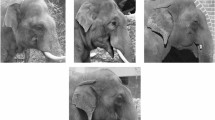Abstract
The present study was carried out to determine if facial and vocal recognition of familiar individuals and vocal-to-facial matching of familiar individuals occurred in common chimpanzees. The matching of different facial portraits and “pant hoot” vocalizations correctly to an array of six facial portraits of familiar individuals randomly sorted from trial-to-trial occurred at greater than chance levels, p >.026. By correctly matching individual chimpanzee faces and vocalizations, the chimpanzees demonstrated their ability to recognize familiar facial configurations and long-distance vocalizations and match these across modes of sensation, prerequisites for monitoring the location and state of fellow group members and avoiding aggressive interactions with less related strangers.
Similar content being viewed by others
References
BASTIAN, J. 1965. Primate signaling system and human languages. In I. DeVore (Ed.), Primate behavior—Field study of monkeys and apes. New York: Holt, Rinehart & Winston.
BAUER, H.R. 1975. Behavioral changes about the time of reunion in parties of chimpanzees in the Gombe National Park. In S. Kondo (Ed.), Contemporary primatology, 5th International Congress of Primatology, Nagoyra, 974. Basel: S. Karger.
BAUER, H.R. 1976. Sex differences in aggregation and sexual selection in the chimpanzees of the Gombe National Park. American Zoologist, 16, 209.
BAUER, H.R. 1977. Ethological aspects of Gombe chimpanzee aggregations with implications for hominization. Dissertation Abstracts International, 38(6), 32. pp.
BAUER, H.R. 1979. Agonistic and grooming behavior in the reunion context of Gombe Stream chimpanzees. In D.A. Hamburg & E.R. McGown (Eds.), The great apes. Menlo Park, California: Benjamin Cummings.
BAUER, H.R. 1980. Chimpanzee society and social dominance in evolutionary perspective. In D.R. Omark, F.F. Strayer, & D. Freeman (Eds.), Dominance relations—Ethological perspectives on human conflict and social interaction. New York: Garland.
BEATTY, J., & McDEVITT, A., 1975. Call discrimination in chimpanzees. Current Anthropology, 16:(4), 668–669.
BEECHER, M.D. 1982. Signature systems and kin recognition. American Zoologist, 22, 477–490.
BEER, C.G. 1970. Individual recognition of voice in the social behavior of birds. In D.S. Lehrman, R.A. Hinde, & E. Shaw (Eds.), Advances in the study of behaviour (Vol. 3). New York: Academic Press.
BOLT, R.H., COOPER, F.S., DAVID, E.E., DENES, R.B., PICKETT, J.M., & STEVENS, K.N. 1970. Speaker identification by speech spectrograms: A scientist’s view of its reliability for legal purposes. Journal of the Acoustical Society of America, 47, 597–612.
BROOKS, R.J., & FALLS, J.B. 1975. Individual recognition by song in white-throated sparrows: Iii. Song features used in individual recognition. Canadian Journal of Zoology, 53, 1749–1761.
BYGOTT, J.D. 1972. Cannibalism among wild chimpanzees. Nature, 238, 410–411.
CHENEY, D.L., & SEYFARTH, R.M. 1980. Vocal recognition in free-ranging vervet monkeys. Animal Behaviour, 28(2), 362–367.
CLIFFORD, B.R., & BULL, R., 1978. The psychology of person identification. Boston: Routledge and Kegan Paul.
COWAN, P.J. 1974. Selective responses to the parental calls of different individual hens by young Gallus: Auditory discrimination learning versus auditory imprinting. Behavioral Biology, 10, 541–545.
DAVENPORT, R.K., & ROGERS, C.M. 1971. Perception of photographs by apes. Behaviour, 39, 2–4.
DAVENPORT, R.K., ROGERS, C.M., & RUSSELL, L.S. 1975. Cross-modal perception in apes: Altered visual cues and delay. Neuropsychologia, 13, 229–235.
ELLIOTT, R.C. 1977. Cross modal recognition in three primates. Neuropsychologica, 15, 183–186.
EMLEN, S.T. 1971. The role of song in individual recognition in the Indigo Bunting. Zeitschrift für Tierpsychologie, 28, 241–246.
FLAVELL, J.H., SHIPSTEAD, S.G., & CROFT, K. 1978. Young children’s knowledge about visual perception: Hiding objects from others. Child Development, 49, 1208–1211.
GALLUP, G. 1970. Chimpanzees: Self-recognition. Science, 167, 86–87.
GALLUP, G., McCLURE, M., HILLS, S., & BUNDY, R.A. 1971. Capacity for self-recognition in differentially reared chimpanzees. The Psychological Record, 21, 69–74.
GARCHA, H.S., & ETTLINGER, G. 1979. Object sorting by chimpanzees and monkeys. Cortex, 15, 213–224.
GOODALL, J. 1965. Chimpanzees in the Gombe Stream Reserve. In I. DeVore (Ed.), Primate behavior. Field study of monkeys and apes. New York: Holt, Rinehart & Winston.
GOODALL, J. 1977. Infant killing and cannibalization in free-ranging chimpanzees. Folia Primatologica, 28, 259–282.
GUHL, A.M., & ORTMAN, L.L. 1953. Visual patterns in the recognition of individuals among chickens. Condor, 15, 287–298.
HANSEN, E.W. 1976. Selective responding by recently separated juvenile Rhesus monkeys to the calls of their mothers. Developmental Psychobiology, 9, (1), 83–88.
HINDE, R.A. 1979. The nature of social structure. In D.A. Hamburg & E. McGown (Eds.), The great apes. Menlo Park, California: Benjamin Cummings.
ITANI, J., & SUZUKI, A. 1967. The social unit of chimpanzees. Primates, 8, 355–381.
KAPLAN, J.N., WINSHIP-BALL, A., & SIM, L., 1978. Maternal discrimination of infant vocalizations in squirrel monkeys. Primate, 19(1), 187–193.
KROODSMA, D., 1976. The effect of large song repertoires on neighbor “recognition” in male song sparrows. Condor, 78, 97–99.
LAWICK-GOODALL, J. VAN. 1968a. The behavior of free-living chimpanzees in the Gombe Stream Reserve. Animal Behaviour Monographs, 1, 161–311.
LAWICK-GOODALL, J. VAN. 1968b. A preliminary report on expressive movements and communications in the Gombe Stream chimpanzees. In P. Jay (Ed.), Primates: Studies in adaptation and variability. New York: Holt, Rinehart & Winston.
LAWICK-GOODALL, J. VAN. 1975. The behaviour of the chimpanzee. In Kurth & I. Eibl-Eibesfeldt (Eds.), Hominisation und Verhalten. Stuttgart: Gustav Fisher Verlag.
LIEBLICH, A.K., SYMMES, D., NEWMAN, J.D., & SHAPIRO, M. 1980. Development of the isolation peep in laboratory-bred squirrel monkeys. Animal behavior, 28(1), 1–9.
MARLER, P. 1976. Social organization, communication and graded signals: The chimpanzee and the gorilla. In P.P.G. Bateson & R.A. Hinde (Eds.), Growing points in ethology. New York: Cambridge University Press.
MARLER, P., & HOBBET, L. 1975. Individuality in a long-range vocalization of wild chimpanzees. Zeitschrift für Tierpsychologie, 38, 97–109.
MASON, W.A. 1970. Chimpanzee social behavior. The Chimpanzee (Vol. 2). New York: Karger.
MASON, W.A. 1976. Environmental models and mental modes: Representational processes in the great apes and man. American Psychologist, 31, 284–294.
MAYNARD-SMITH, J. 1978. The evolution of behavior. Scientific American, 239(3), 176–192.
MENZEL, E.W. 1974. A group of young chimpanzees in a one-acre field enclosure. In A.M. Sender & F. Stollnitz (Eds.), Behavior of nonhuman primates (Vol. 5). New York: Academic Press.
PETRINOVICH, L., 1974. Individual recognition of pup vocalizations by northern elephant seal mothers. Zeitschrift für Tierpsychologie, 34, 308–312.
PREMACK, D. 1976. Intelligence in apes and man. New York: Erlbaum.
PREMACK, D., WOODRUFF, G., & KENNEL, K. 1978. Paper marking test for chimpanzee: Simple control for social cues. Science, 202, 903–905.
SAUNDERS, A.A. 1924. Recognizing individual birds by song. Auk, 41, 242–259.
SIGEL, I.E. 1978. The development of pictorial comprehension. In B.S. Randhawa & W.E. Cossman (Eds.), Visual learning-Thinking and communication. New York: Academic Press.
SNOWDON, C.T., & CLEVELAND, J. 1980. Individual recognition of contact calls by pygmy marmosets. Animal Behaviour, 28, 717–727.
SUZUKI, A. 1971. Carnivory and cannibalism observed among forest-living chimpanzees. Journal of the Anthropological Society ofRippon, 79(1), 30–48.
TELEKI, G. 1973. The predatory behavior of wild chimpanzees. Lewisburg, Pennsylvania: Bucknell University Press.
TERRACE, H.S. 1979. Nim—A chimpanzee who learned sign language. New York: Alfred A. Knopf.
TRIVERS, R.L. 1971. The evolution of reciprocal altruism. Quarterly Review of Biology, 46, 35–57.
WASER, P.M. 1977. Experimental studies of Primate vocalizations: Specializations for longdistance propagation. Zeitschrift f. Tierpsychologie, As, 239–263.
WHITE, S.J., WHITE, R.E.S., & THORPE, W.H. 1970. Acoustic basis for individual recognition by voice in the gannet. Nature, 225, 1156–1158.
WILSON, E.O. 1975. Sociobiology, the new synthesis. Cambridge, Massachusetts: University Press.
WRANGHAM, R.W., 1977. Feeding behaviour of chimpanzees in Gombe National Park, Tanzania. In T.H. Clutton-Brock (Ed.), Primate ecology: Studies of feeding and ranging behaviours in lemurs, monkeys and apes. New York: Academic Press.
YENI-KOMSHIAN, G.H., & BENSON, D.A. 1976. Anatomical study of cerebral asymmetry in the temporal lobe of humans, chimpanzees and rhesus monkeys. Science, 192, 387–389.
Author information
Authors and Affiliations
Additional information
This study was made possible by the cooperation and assistance of William Lemmon, Director, Institute for Primate Studies, University of Oklahoma, Norman, and his assistants. We thank the Departments of Psychology and Linguistics of Bucknell University for support during the research and Alexander von Humboldt Foundation, West Germany, NSF, and the NINCDS for support in preparation of the manuscript.
Rights and permissions
About this article
Cite this article
Bauer, H.R., Philip, M.M. Facial and Vocal Individual Recognition in the Common Chimpanzee. Psychol Rec 33, 161–170 (1983). https://doi.org/10.1007/BF03394834
Published:
Issue Date:
DOI: https://doi.org/10.1007/BF03394834




